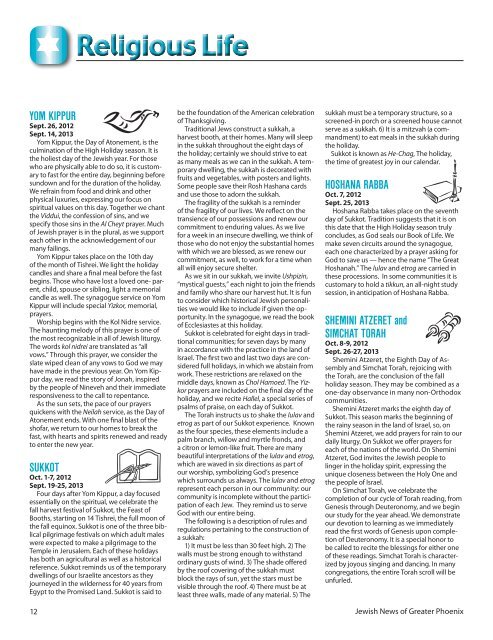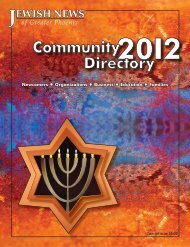downloadable PDF - Jewish News of Greater Phoenix
downloadable PDF - Jewish News of Greater Phoenix
downloadable PDF - Jewish News of Greater Phoenix
You also want an ePaper? Increase the reach of your titles
YUMPU automatically turns print PDFs into web optimized ePapers that Google loves.
ì<br />
12<br />
Religious Life<br />
YOM KIPPUR<br />
Sept. 26, 2012<br />
Sept. 14, 2013<br />
Yom Kippur, the Day <strong>of</strong> Atonement, is the<br />
culmination <strong>of</strong> the High Holiday season. It is<br />
the holiest day <strong>of</strong> the <strong>Jewish</strong> year. For those<br />
who are physically able to do so, it is customary<br />
to fast for the entire day, beginning before<br />
sundown and for the duration <strong>of</strong> the holiday.<br />
We refrain from food and drink and other<br />
physical luxuries, expressing our focus on<br />
spiritual values on this day. Together we chant<br />
the Viddui, the confession <strong>of</strong> sins, and we<br />
specify those sins in the Al Cheyt prayer. Much<br />
<strong>of</strong> <strong>Jewish</strong> prayer is in the plural, as we support<br />
each other in the acknowledgement <strong>of</strong> our<br />
many failings.<br />
Yom Kippur takes place on the 10th day<br />
<strong>of</strong> the month <strong>of</strong> Tishrei. We light the holiday<br />
candles and share a final meal before the fast<br />
begins. Those who have lost a loved one- parent,<br />
child, spouse or sibling, light a memorial<br />
candle as well. The synagogue service on Yom<br />
Kippur will include special Yizkor, memorial,<br />
prayers.<br />
Worship begins with the Kol Nidre service.<br />
The haunting melody <strong>of</strong> this prayer is one <strong>of</strong><br />
the most recognizable in all <strong>of</strong> <strong>Jewish</strong> liturgy.<br />
The words kol nidrei are translated as “all<br />
vows.” Through this prayer, we consider the<br />
slate wiped clean <strong>of</strong> any vows to God we may<br />
have made in the previous year. On Yom Kippur<br />
day, we read the story <strong>of</strong> Jonah, inspired<br />
by the people <strong>of</strong> Nineveh and their immediate<br />
responsiveness to the call to repentance.<br />
As the sun sets, the pace <strong>of</strong> our prayers<br />
quickens with the Neilah service, as the Day <strong>of</strong><br />
Atonement ends. With one final blast <strong>of</strong> the<br />
sh<strong>of</strong>ar, we return to our homes to break the<br />
fast, with hearts and spirits renewed and ready<br />
to enter the new year.<br />
SUKKOT<br />
Oct. 1-7, 2012<br />
Sept. 19-25, 2013<br />
Four days after Yom Kippur, a day focused<br />
essentially on the spiritual, we celebrate the<br />
fall harvest festival <strong>of</strong> Sukkot, the Feast <strong>of</strong><br />
Booths, starting on 14 Tishrei, the full moon <strong>of</strong><br />
the fall equinox. Sukkot is one <strong>of</strong> the three biblical<br />
pilgrimage festivals on which adult males<br />
were expected to make a pilgrimage to the<br />
Temple in Jerusalem. Each <strong>of</strong> these holidays<br />
has both an agricultural as well as a historical<br />
reference. Sukkot reminds us <strong>of</strong> the temporary<br />
dwellings <strong>of</strong> our Israelite ancestors as they<br />
journeyed in the wilderness for 40 years from<br />
Egypt to the Promised Land. Sukkot is said to<br />
be the foundation <strong>of</strong> the American celebration<br />
<strong>of</strong> Thanksgiving.<br />
Traditional Jews construct a sukkah, a<br />
harvest booth, at their homes. Many will sleep<br />
in the sukkah throughout the eight days <strong>of</strong><br />
the holiday; certainly we should strive to eat<br />
as many meals as we can in the sukkah. A temporary<br />
dwelling, the sukkah is decorated with<br />
fruits and vegetables, with posters and lights.<br />
Some people save their Rosh Hashana cards<br />
and use those to adorn the sukkah.<br />
The fragility <strong>of</strong> the sukkah is a reminder<br />
<strong>of</strong> the fragility <strong>of</strong> our lives. We reflect on the<br />
transience <strong>of</strong> our possessions and renew our<br />
commitment to enduring values. As we live<br />
for a week in an insecure dwelling, we think <strong>of</strong><br />
those who do not enjoy the substantial homes<br />
with which we are blessed, as we renew our<br />
commitment, as well, to work for a time when<br />
all will enjoy secure shelter.<br />
As we sit in our sukkah, we invite Ushpizin,<br />
“mystical guests,” each night to join the friends<br />
and family who share our harvest hut. It is fun<br />
to consider which historical <strong>Jewish</strong> personalities<br />
we would like to include if given the opportunity.<br />
In the synagogue, we read the book<br />
<strong>of</strong> Ecclesiastes at this holiday.<br />
Sukkot is celebrated for eight days in traditional<br />
communities; for seven days by many<br />
in accordance with the practice in the land <strong>of</strong><br />
Israel. The first two and last two days are considered<br />
full holidays, in which we abstain from<br />
work. These restrictions are relaxed on the<br />
middle days, known as Chol Hamoed. The Yizkor<br />
prayers are included on the final day <strong>of</strong> the<br />
holiday, and we recite Hallel, a special series <strong>of</strong><br />
psalms <strong>of</strong> praise, on each day <strong>of</strong> Sukkot.<br />
The Torah instructs us to shake the lulav and<br />
etrog as part <strong>of</strong> our Sukkot experience. Known<br />
as the four species, these elements include a<br />
palm branch, willow and myrtle fronds, and<br />
a citron or lemon-like fruit. There are many<br />
beautiful interpretations <strong>of</strong> the lulav and etrog,<br />
which are waved in six directions as part <strong>of</strong><br />
our worship, symbolizing God’s presence<br />
which surrounds us always. The lulav and etrog<br />
represent each person in our community: our<br />
community is incomplete without the participation<br />
<strong>of</strong> each Jew. They remind us to serve<br />
God with our entire being.<br />
The following is a description <strong>of</strong> rules and<br />
regulations pertaining to the construction <strong>of</strong><br />
a sukkah:<br />
1) It must be less than 30 feet high. 2) The<br />
walls must be strong enough to withstand<br />
ordinary gusts <strong>of</strong> wind. 3) The shade <strong>of</strong>fered<br />
by the ro<strong>of</strong> covering <strong>of</strong> the sukkah must<br />
block the rays <strong>of</strong> sun, yet the stars must be<br />
visible through the ro<strong>of</strong>. 4) There must be at<br />
least three walls, made <strong>of</strong> any material. 5) The<br />
sukkah must be a temporary structure, so a<br />
screened-in porch or a screened house cannot<br />
serve as a sukkah. 6) It is a mitzvah (a commandment)<br />
to eat meals in the sukkah during<br />
the holiday.<br />
Sukkot is known as He-Chag, The holiday,<br />
the time <strong>of</strong> greatest joy in our calendar.<br />
HOSHANA RABBA<br />
Oct. 7, 2012<br />
Sept. 25, 2013<br />
Hoshana Rabba takes place on the seventh<br />
day <strong>of</strong> Sukkot. Tradition suggests that it is on<br />
this date that the High Holiday season truly<br />
concludes, as God seals our Book <strong>of</strong> Life. We<br />
make seven circuits around the synagogue,<br />
each one characterized by a prayer asking for<br />
God to save us — hence the name “The Great<br />
Hoshanah.” The lulav and etrog are carried in<br />
these processions. In some communities it is<br />
customary to hold a tikkun, an all-night study<br />
session, in anticipation <strong>of</strong> Hoshana Rabba.<br />
SHEMINI ATZERET and<br />
SIMCHAT TORAH<br />
Oct. 8-9, 2012<br />
Sept. 26-27, 2013<br />
Shemini Atzeret, the Eighth Day <strong>of</strong> Assembly<br />
and Simchat Torah, rejoicing with<br />
the Torah, are the conclusion <strong>of</strong> the fall<br />
holiday season. They may be combined as a<br />
one-day observance in many non-Orthodox<br />
communities.<br />
Shemini Atzeret marks the eighth day <strong>of</strong><br />
Sukkot. This season marks the beginning <strong>of</strong><br />
the rainy season in the land <strong>of</strong> Israel, so, on<br />
Shemini Atzeret, we add prayers for rain to our<br />
daily liturgy. On Sukkot we <strong>of</strong>fer prayers for<br />
each <strong>of</strong> the nations <strong>of</strong> the world. On Shemini<br />
Atzeret, God invites the <strong>Jewish</strong> people to<br />
linger in the holiday spirit, expressing the<br />
unique closeness between the Holy One and<br />
the people <strong>of</strong> Israel.<br />
On Simchat Torah, we celebrate the<br />
completion <strong>of</strong> our cycle <strong>of</strong> Torah reading, from<br />
Genesis through Deuteronomy, and we begin<br />
our study for the year ahead. We demonstrate<br />
our devotion to learning as we immediately<br />
read the first words <strong>of</strong> Genesis upon completion<br />
<strong>of</strong> Deuteronomy. It is a special honor to<br />
be called to recite the blessings for either one<br />
<strong>of</strong> these readings. Simchat Torah is characterized<br />
by joyous singing and dancing. In many<br />
congregations, the entire Torah scroll will be<br />
unfurled.<br />
<strong>Jewish</strong> <strong>News</strong> <strong>of</strong> <strong>Greater</strong> <strong>Phoenix</strong>



